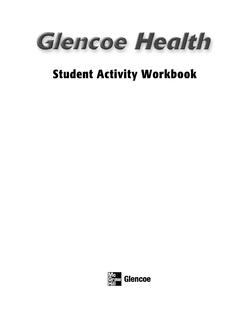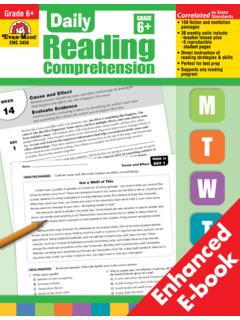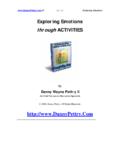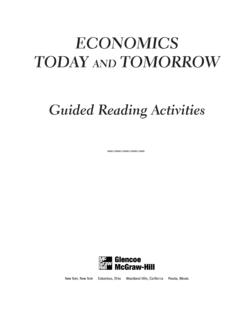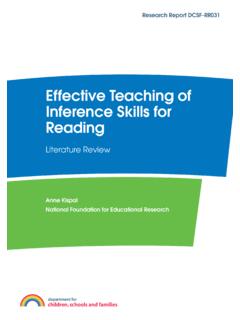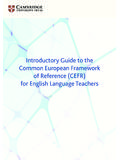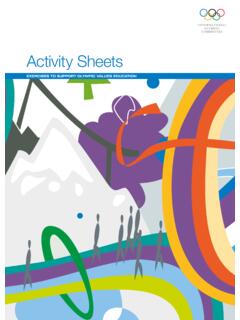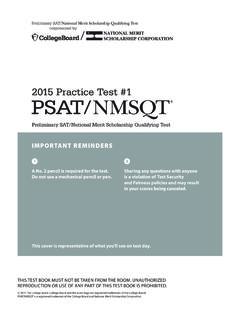Transcription of Guided Reading Activities - Welcome to Mr. Bextermueller's ...
1 Guided ReadingActivitiesGuided ReadingActivitiesTo the TeacherThe United States Government: Democracy In ActionGuided Reading Activities booklet providesactivities for students who would benefit from a review of the material. By focusing attention onkey information and concepts, Guided Reading Activities enable students to understand and make appropriate connections among the facts they encounter in the student by The McGraw-Hill Companies, Inc. All rights reserved. Permission is granted toreproduce the material contained herein on the condition that such material be reproduced only forclassroom use; be provided to students, teachers, and families, without charge; and be used solelyin conjunction with United States Government: Democracy In Action. Any other reproduction, foruse or sale, is prohibited without written permission from the all inquiries to:Glencoe/McGraw-Hill8787 Orion PlaceColumbus, Ohio 43240 ISBN 0-07-865911-6 Printed in the United States of America1234567891004708070605 Customize Your ResourcesNo matter how you organize your teaching resources, Glencoe has what you Teacher Classroom Resources for United States Government: Democracy In Action providesyou with a wide variety of supplemental materials to enhance the classroom experience.
2 Theseresources appear as individual booklets in a carryall tote box. The booklets are designed to openflat so that pages can be easily photocopied without removing them from their booklet. However,if you choose to create separate files, the pages are perforated for easy removal. You may customizethese materials using our file folders or tabbed individual booklets and the file management kit supplied in Teacher Classroom Resourcesgive you the flexibility to organize these resources in a combination that best suits your teachingstyle. Below are several alternatives: Organize all resources by category(all tests, all enrichment and extension Activities ,all cooperative learning Activities , etc., filed separately) Organize all resources by category and chapter (all Chapter 1 Activities , all Chapter 1 tests, etc.)
3 Organize resources sequentially by lesson( Activities , quizzes, readings, etc., for Chapter 1, Chapter 2, and so on) Guided Reading ActivitiesiiiTable of ContentsTo the Teacher .. iiGuided Reading ActivitiesUNIT 1 Foundations of American GovernmentActivity 1-1 Principles of 1 Activity 1-2 The Formation of Governments .. 2 Activity 1-3 Types of 1-4 Economic Theories .. 4 Activity 2-1 The Colonial Period .. 5 Activity 2-2 Uniting for 2-3 The Articles of Confederation .. 7 Activity 2-4 The Constitutional Convention .. 8 Activity 3-1 Structure and Principles .. 9 Activity 3-2 Three Branches of Government .. 10 Activity 3-3 Amending the 11 Activity 3-4 The Amendments .. 12 Activity 4-1 National and State Powers ..13 Activity 4-2 Relations Among the States .. 14 Activity 4-3 Developing 15 Activity 4-4 Federalism and Politics.
4 16 UNIT 2 The Legislative BranchActivity 5-1 Congressional Membership .. 17 Activity 5-2 The House of Representatives .. 18 Activity 5-3 The 19 Activity 5-4 Congressional Committees .. 20 Activity 5-5 Staff and Support 21 Activity 6-1 Constitutional Powers .. 22 Activity 6-2 Investigations and Oversight .. 23 Activity 6-3 Congress and the President .. 24 Activity 7-1 How a Bill Becomes a Law .. 25 Activity 7-2 Taxing and Spending 7-3 Influencing Congress .. 27 Activity 7-4 Helping Constituents .. 28 UNIT 3 The Executive BranchActivity 8-1 President and Vice President .. 29 Activity 8-2 Electing the 30 Activity 8-3 The Cabinet .. 31 Activity 8-4 The Executive Office .. 32 ivGuided Reading ActivitiesActivity 9-1 Presidential 33 Activity 9-2 Roles of the 34 Activity 9-3 Styles of 35 Activity 10-1 Bureaucratic 10-2 The Civil Service System.
5 37 Activity 10-3 The Bureaucracy at Work .. 38 UNIT 4 The Judicial BranchActivity 11-1 Powers of the Federal 39 Activity 11-2 Lower Federal Courts .. 40 Activity 11-3 The Supreme 41 Activity 12-1 The Supreme Court at Work .. 42 Activity 12-2 Shaping Public 43 Activity 12-3 Influencing Court 44 UNIT 5 Liberty and Justice for AllActivity 13-1 Constitutional Rights .. 45 Activity 13-2 Freedom of 46 Activity 13-3 Freedom of Speech .. 47 Activity 13-4 Freedom of the 48 Activity 13-5 Freedom of Assembly ..49 Activity 14-1A Nation of Immigrants .. 50 Activity 14-2 The Basis of 51 Activity 14-3 The Rights of the Accused .. 52 Activity 14-4 Equal Protection of the Law .. 53 Activity 14-5 Challenges for Civil 15-1 Sources of American Law .. 55 Activity 56 Activity 15-3 Criminal Law .. 57 UNIT 6 Participating in GovernmentActivity 16-1 Development of 16-2 Party Organization.
6 59 Activity 16-3 Nominating Candidates ..60 Activity 17-1 Election Campaigns .. 61 Activity 17-2 Expanding Voting Rights ..62 Activity 17-3 Influences onVoters .. 63 Activity 18-1 Interest Group Organization .. 64 Activity 18-2 Affecting Public Policy .. 65 Activity 18-3 Shaping Public 18-4 Measuring Public Opinion .. 67 Guided Reading ActivitiesvActivity 19-1 How Media Impact Government .. 68 Activity 19-2 Regulating Print and Broadcast Media .. 69 Activity 19-3 The Internet and Democracy .. 70 UNIT 7 Public Policies and ServicesActivity 20-1 Raising Money .. 71 Activity 20-2 Preparing the Federal Budget .. 72 Activity 20-3 Managing the Economy .. 73 Activity 21-1 Business and Labor Policy ..74 Activity 21-2 Agriculture and the Environment .. 75 Activity 21-3 Health and Public Assistance .. 76 Activity 21-4 Education, Housing, and Transportation.
7 77 Activity 22-1 Development of Foreign Policy .. 78 Activity 22-2 Shared Foreign Policy 79 Activity 22-3 State and Defense Departments .. 80 Activity 22-4 Foreign Policy in 81 UNIT 8 State and Local GovernmentActivity 23-1 State Constitutions .. 82 Activity 23-2 The Three Branches .. 83 Activity 23-3 State Government 23-4 Financing State Government .. 85 Activity 24-1 Structure of Local 86 Activity 24-2 Serving 87 Activity 24-3 Challenges of Urban 88 UNIT 9 Political and Economic SystemsActivity 25-1 Democratic 89 Activity 25-2 Authoritarian Governments .. 90 Activity 25-3 International Organizations .. 91 Activity 25-4 Global Issues .. 92 Activity 26-1 Capitalist and Mixed Systems .. 93 Activity 26-2 Emerging Economies ..94 Activity 26-3 Major Economies in 95 Activity 26-4 The Global 97 viGuided Reading ActivitiesPrinciples of GovernmentDIRECTIONSUse the information in your textbook to name the essential features of a state and towrite a short description of each the information in your textbook to complete the diagram.
8 PurposesPositive EffectsName Date Class Guided Reading Activities1 Guided Reading Activity 1-1 Copyright by The McGraw-Hill Companies, STATE: ESSENTIAL FEATURES AS EXEMPLIFIED IN THE UNITED STATESTHE PURPOSES AND EFFECTS OF GOVERNMENTPURPOSESTYPES OF CONSTITUTIONSW rittenUnwrittenExamplesExamplesCHARACTER ISTICSS tatement of GoalsPreambleFramework forExamples from the PreambleHighest LawGovernmentWhat It DoesWhat It DoesThe Formation of GovernmentsDIRECTIONSUse your textbook to complete the diagram illustrating the purposes and characteristicsof a nation s the chart of the three major kinds of nations in today s world. Name Date Class 2 Guided Reading ActivitiesGuided Reading Activity 1-2 Copyright by The McGraw-Hill Companies, AND CHARACTERISTICS OF A CONSTITUTIONC haracteristicsCharacteristicsCharacteris ticsHow They Are InterdependentHow They Are InterdependentHow They Are InterdependentINTERDEPENDENCE AMONG NATIONS TODAYI ndustrialized NationsNewly Industrialized NationsDeveloping NationsAUTOCRACYOLIGARCHYDEMOCRACYT ypesDescriptionTypesDescriptionDescripti onTypesExampleExampleExampleExampleExamp leExampleTypes of GovernmentDIRECTIONSUse the information in your textbook to complete the diagram of the three majortypes of the example of democracy in Column A with the characteristic of democracy inColumn B.
9 Write the correct letter in the blank. Name Date Class Guided Reading Activities3 Guided Reading Activity 1-3 Copyright by The McGraw-Hill Companies, TYPES OF GOVERNMENTSC olumn A are free to develop their own capacities. choose among candidates of several parties. s vote carries the same weight. tests cannot be used to restrict voting. Constitution ensures protection of minority rights. presence helps focus attention on key rule with minority political partiesECONOMIC CHARACTERISTICS OF CAPITALISM, SOCIALISM, AND COMMUNISMC apitalismSocialismCommunismOwnership of propertyPrinciple of operationChoice of workWagesProfitsGovernment s roleGovernment involvementAmount of competitionProduction decisionsEconomic Theories DIRECTIONSUse the information in your textbook to complete the the information in your textbook to match time and events.
10 Next to each economic event write the letter of the year or the era in which it occurred. Name Date Class 4 Guided Reading ActivitiesGuided Reading Activity 1-4 Copyright by The McGraw-Hill Companies, A Smith writes The Wealth ofNations. China begins allowinglimited capitalism. Marx writes Das Kapitalin whichhe interprets human history as a classstruggle between owners and workers. United States government increasesits regulation of the economy. socialism begins. Marx foresees a Communistrevolution against capitalism resultingin a one-class nineteenth later twentieth early twentieth centuryName Date Class The Colonial PeriodDIRECTIONSUse the information in your textbook to complete the chart. First, define each idea inyour own words. Then, give examples that illustrate how each idea was put into practice.
